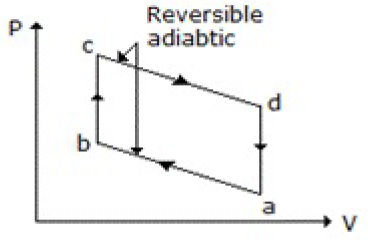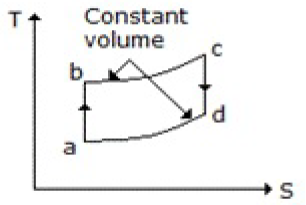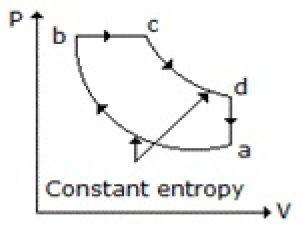Entropy change in case of reversible adiabatic process is
Minimum
Zero
Maximum
Indeterminate
Correct Answer :
B. Zero
Related Questions
For the gaseous phase chemical reaction, C2H4(g) + H2O(g) ↔ C2H5OH(g), the equilibrium conversion does not depend on the
Steam to ethylene ratio
Temperature
Pressure
None of these
Pick out the wrong statement.
At constant pressure, solubility of a gas in a liquid diminishes with rise in temperature
Normally, the gases which are easily liquefied are more soluble in common solvents
The gases which are capable of forming ions in aqueous solution are much more soluble in water than in other solvents
At constant pressure, solubility of a gas in a liquid increases with rise in temperature
In a homogeneous solution, the activity coefficient of a component depends upon the
Pressure
Composition
Temperature
All (A), (B) and (C)
Compound having large heat of formation is
More stable
Less stable
Not at all stable (like nascent O2)
Either more or less stable; depends on the compound
In case of vapour compression refrigeration system, elevating the evaporator temperature (keeping the condenser temperature constant) results in
Enhanced COP
Decreased COP
No change in the value of COP
Increased or decreased COP; depending upon the type of refrigerant
Equilibrium constant of a reaction varies with the
Initial concentration of the reactant
Pressure
Temperature
None of these
Equilibrium constant decreases as the temperature
Increases, for an exothermic reaction
Decreases, for an exothermic reaction
Increases, for an endothermic reaction
None of these
Isotherm on an enthalpy-concentration diagram, for an ideal solution will be a
Straight line
Sine curve
Parabola
Hyperbola
Gibbs free energy (F) is defined as
F = E - TS
F = H - TS
F = H + TS
F = E + TS
The expression for entropy change, ΔS = n Cp . ln (T2/T1), is valid for the __________ of a substance.
Simultaneous pressure & temperature change
Heating
Cooling
Both (B) and (C)
Isentropic process means a constant __________ process.
Enthalpy
Pressure
Entropy
None of these
Henry's law is closely obeyed by a gas, when its __________ is extremely high.
Pressure
Solubility
Temperature
None of these
Work done is a
Property of the system
Path function
Point function
State description of a system
At normal boiling point, molar entropy of vaporisation is __________ Joule/K°.mole.
72
92
142
192
Chemical potential of ith component of a system is given by
μi = (∂F/∂ni)T, P, ni
μi = (∂A/∂ni)T, P, ni
μi = (∂F/∂ni)T, P
μi = (∂A/∂ni)T, P
Heat is added at constant pressure in an ideal __________ cycle.
Stirling
Brayton
Rankine
Both (B) and (C)
Out of the following refrigeration cycles, which one has the minimum COP (Co-efficient of performance)?
Air cycle
Carnot cycle
Ordinary vapour compression cycle
Vapour compression with a reversible expansion engine
Refrigerants commonly used for domestic refrigerators are
Ethyl chloride or methyl chloride
Freon-12
Propane
NH3 or CO2
In a homogeneous solution, the fugacity of a component depends upon the
Pressure
Composition
Temperature
All (A), (B) and (C)
In the equation, PVn = constant, if the value of n = ± ∞, then it represents a reversible __________ process.
Adiabatic
Isometric
Isentropic
Isothermal
Joule-Thomson co-efficient which is defined as, η = (∂T/∂P)H = 1/Cp (∂H/∂T)P, changes sign at a temperature known as inversion temperature. The value of Joule-Thomson co-efficient at inversion temperature is
0
∞
+ve
-ve
With increase in reduced temperature, the fugacity co-efficient of a gas at constant reduced pressure
Increases
Decreases
Remain same
Decreases linearly
In an ideal solution, the activity of a component equals its
Mole fraction
Fugacity at the same temperature and pressure
Partial pressure
None of these
Filling of gas from a high pressure cylinder into small bottles is an example of a/an __________ process.
Equilibrium
Adiabatic
Steady
Unsteady
The Joule-Thomson co-efficient is defined as (∂T/∂P)H. Its value at the inversion point is
∞
1
0
-ve
Which of the following diagrams does not represent an Otto cycle?



None of these
In any spontaneous process, the __________ free energy decreases.
Helmholtz
Gibbs
Both a & b
Neither 'a' nor 'b'
Free energy change of mixing two liquid substances is a function of the
Concentration of the constituents only
Quantities of the constituents only
Temperature only
All (A), (B) and (C)
Domestic refrigerator usually works on the __________ refrigeration cycle.
Carnot
Air
Absorption
vapour-ejection
Which of the following liquid metals has the highest thermal conductivity?
Molten sodium
Molten lead
Mercury
Molten potassium
